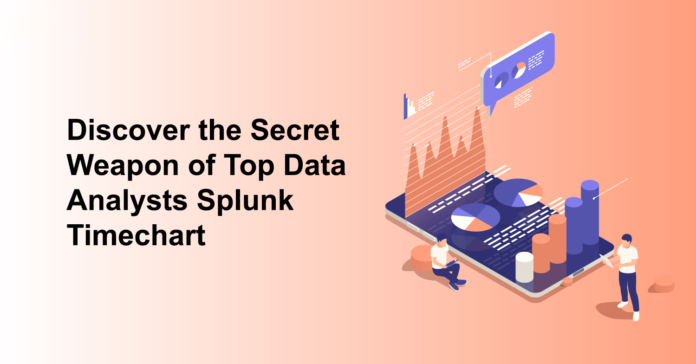Data analysis is increasingly becoming an essential component of decision-making processes in various industries. As businesses strive to leverage the power of data, top data analysts are constantly seeking innovative tools and techniques to extract valuable insights efficiently. Among these tools, Splunk Timechart has emerged as a secret weapon for these analytical wizards. With its robust capabilities and user-friendly interface, Splunk Timechart empowers analysts to navigate through vast amounts of complex data effortlessly, enabling them to uncover hidden patterns, trends, and anomalies that might otherwise remain undiscovered. In this article, we delve into the world of Splunk Timechart and explore how it has revolutionised the way data analysts approach their work – ultimately leading them towards making informed decisions that drive business success.
What is Splunk Timechart: Explanation and features
Splunk Timechart is a powerful feature of Splunk that allows users to create time-based visualisations and analyse data trends over a specified period. With Splunk Timechart, data analysts can easily identify patterns, anomalies, and correlations in their data.
One key feature of Splunk Timechart is its ability to aggregate and summarise data based on specific time intervals such as seconds, minutes, hours, or days. This enables users to gain insights into the behaviour of their data over different time periods. Additionally, Timechart provides various functions and options for manipulating and formatting time-series data, allowing analysts to customise their visualisations according to their needs.
Moreover, Splunk Timechart offers a wide range of visualisation options including line charts, column charts, area charts, and more. These visualisations not only make it easier for users to understand complex datasets but also provide a clear representation of how the data changes over time. By leveraging the power of Splunk Timechart’s features and capabilities, data analysts can effectively uncover hidden patterns in their datasets and make informed decisions based on accurate insights.
How Splunk Timechart enhances data analysis: Benefits and advantages
Splunk Timechart is a powerful tool that revolutionises the way data analysis is conducted. With its advanced capabilities, it allows analysts to gain deeper insights into their data and make more informed decisions. One of the main benefits of using Splunk Timechart is its ability to visualise time-based data in a meaningful way. By displaying trends and patterns over time, analysts can easily identify anomalies or detect recurring events in their datasets.
Additionally, Splunk Timechart offers great flexibility and customization options. Analysts can easily adjust the granularity of their visualisations, allowing them to zoom in on specific time intervals or zoom out for a broader view. This level of control enables them to focus on relevant details and extract valuable insights from large datasets efficiently.
Furthermore, this tool provides real-time analysis capabilities, which are particularly useful when dealing with streaming or constantly updating data sources. By utilising Splunk Timechart’s real-time features, analysts can monitor their data as it flows in and quickly respond to any changes or abnormalities that may arise.
In conclusion, Splunk Timechart enhances data analysis by providing powerful visualisation capabilities, customizable views, and real-time analysis features. By leveraging these benefits and advantages, analysts can unlock hidden patterns in their datasets and make well-informed decisions based on accurate insights derived from time-based data.
Real-world examples of using Splunk Timechart: Case studies
- Case Study 1: Improving Security Operations
One real-world example of using Splunk Timechart is in the field of security operations. A large financial institution was struggling to effectively monitor and respond to security incidents across their network infrastructure. By implementing Splunk’s timechart feature, they were able to visualise and analyse log data in real-time, enabling them to quickly identify potential security threats and take immediate action. The timechart functionality allowed them to track patterns and anomalies over time, helping them detect any suspicious activities or breaches more efficiently.
- Case Study 2: Optimising IT Infrastructure Performance
Another practical application of Splunk Timechart can be seen in optimising IT infrastructure performance. A global technology company faced challenges with managing a complex network infrastructure spanning multiple locations worldwide. They used the timechart feature to gather and analyse data from various sources such as servers, switches, and applications. By visualising this information through interactive charts and graphs, they gained valuable insights into their system’s behaviour patterns and identified areas for improvement or optimization. This helped them proactively address performance issues before they escalated into major disruptions, resulting in enhanced operational efficiency overall.
Conclusion: Unlocking the power of Splunk Timechart in data analysis.
In conclusion, the power of Splunk Timechart in data analysis cannot be overstated. With its robust capabilities and user-friendly interface, it has become a secret weapon for top data analysts. The ability to visualise and manipulate time-based data allows analysts to uncover valuable insights and trends that may otherwise go unnoticed.
One key advantage of Splunk Timechart is its flexibility in handling large volumes of data. Analysts can easily filter, aggregate, and transform data based on specific time intervals or criteria. This enables them to identify patterns, anomalies, and correlations within datasets more efficiently.
Additionally, Splunk Timechart offers various visualisation options such as line charts, bar charts, and scatter plots. These visual representations simplify complex time-based information, making it easier for analysts to communicate their findings to stakeholders effectively.
Overall, when utilised effectively in data analysis workflows, Splunk Timechart has the potential to unlock hidden opportunities and drive informed decision-making processes within organisations. Its versatility and user-friendly features make it an invaluable tool for any analyst looking to harness the power of time-based data.
Author Bio:
Shahanaaz Begum Shaik is a technologically savvy SEO Research Analyst. I am passionate about researching various technologies, startups, and big dreams in order to achieve various goals. I have extensive experience presenting information on market-leading technologies such as Palo Alto, SAP, Looker, AWS, Peoplesoft, Splunk, Splunk Timechart, Denodo, Mainframes Interview questions, Tosca and Servicenow etc.















